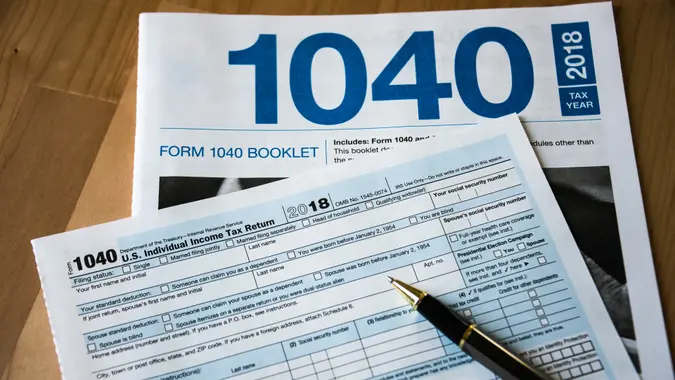Advertiser Disclosure
GOBankingRates works with many financial advertisers to showcase their products and services to our audiences. These brands compensate us to advertise their products in ads across our site. This compensation may impact how and where products appear on this site. We are not a comparison-tool and these offers do not represent all available deposit, investment, loan or credit products.
All the Numbers You Need To Know for Your 2020 Taxes
 Written by
Andrew Lisa
Written by
Andrew Lisa

Commitment to Our Readers
GOBankingRates' editorial team is committed to bringing you unbiased reviews and information. We use data-driven methodologies to evaluate financial products and services - our reviews and ratings are not influenced by advertisers. You can read more about our editorial guidelines and our products and services review methodology.

20 YearsHelping You Live Richer

Reviewed by Experts

Trusted by Millions of Readers
Taxes are all about numbers. How much income did you earn? What percentage of that income can be taxed? At what rate? How much have you already paid? How much is still owed or needs to be refunded?
In order to answer those questions and more, people need to consider and calculate all kinds of numbers when tax season rolls around. The following is a list of 10 of the most important numbers that you’ll need to know now that it’s that time of year again. Understanding them is the key to maximizing the only two numbers that really matter: how much of your money you get to keep and how much you have to turn over to the taxman.
5: Number of Filing Statuses
Just like last year, you’ll fall into one of five filing status categories no matter your income and no matter your tax bracket. That classification will determine the rate you’ll pay depending on your income. The five statuses are:
- Single
- Married filing jointly
- Married filing separately
- Head of household
- Qualifying widow(er) with dependent child
7: Number of Tax Brackets
Your specific tax bracket also figures into the rate you’ll pay based on your income. The more money you earn, the greater percentage is taxed. There are seven tax brackets this year, the same as there were in 2020 when filing for tax year 2019. The single/joint 2020 tax brackets are:
- 12% for incomes over $9,875/$19,750
- 22% for incomes over $40,125/$80,250
- 24% for incomes over $85,525/$171,050
- 32% for incomes over $163,300/$326,600
- 35% for incomes over $207,350/$414,700
- 37% for incomes over $518,400/$622,050
21: Number of Days Until Refunds Arrive
The IRS issues more than 90% of all refunds within 21 days of accepting a taxpayer’s returns. Direct deposit is the fastest and safest way to get your money — the IRS urges everyone to sign up, which about 80% of American taxpayers already have. If three weeks pass without your refund arriving, use the IRS’ “Where’s My Refund?” tool to check the status.
$2,874: Amount of the Average Refund
In 2020, the average tax refund was just a few dollars less than the $2,888 average refund from 2019. The IRS issued nearly 103 million refunds in total, about 85.33 million of which were via direct deposit. In total, the IRS refunded more than $245 billion to its rightful owners.
$2,000: Maximum Child Tax Credit
You can take up to $2,000 for the Child Tax Credit for each qualifying child through age 17. Up to $1,400 of it is refundable, meaning you can receive that amount even if you don’t owe any tax. Dependents who don’t qualify can still get up to $500 each from the credit, which is fazed out at individual incomes over $200,000 or joint incomes over $400,000. Unlike a deduction, which reduces taxable income, the credit directly lowers your tax bill or increases your refund.
$6,000: Maximum Earned Income Tax Credit
The Earned Income Tax Credit subsidizes low- and moderate-income taxpayers, particularly those with children. In 2020, the maximum credit for those who meet the income requirements but don’t have any qualifying children is $538. For those with three children, it goes all the way up to $6,660. The credit increases with each child and gets smaller gradually as incomes rise until the credit runs out altogether at each tier’s maximum income.
$12,400: Standard Deduction
Unlike tax credits that reduce your tax bill directly on a dollar-for-dollar basis, the standard deduction lowers the amount of your income that can be taxed in the first place. For individual filers, the standard deduction is $12,400 for tax year 2020, up $200 from last year. For married couples filing jointly, it’s $24,800, which is an increase of $400 over last year. You must choose between the standard deduction and itemized deductions.
$300: Special 2020 Charity Deduction
One of the rare times you can take the standard deduction and still itemize is through a program new for 2020 that was designed to encourage charitable giving during COVID-19. Even those who took the standard deduction can write off up to $300 in cash donations made to charity before Dec. 31, 2020.
15.3%: Self-Employment Tax
Sole proprietors pay handsomely for the privilege of working for themselves. Payroll taxes fund Social Security and Medicare, with the employer and the worker each paying 6.2% and 1.45% toward those programs, respectively. Freelancers, independent contractors and other self-employed people have to contribute as both the employer and the employee, which doubles the rate. What’s known as the self-employment tax, therefore, is a bruising 15.3% tribute that must be paid to earn the right to work for yourself.
$72,900: Alternative Minimum Tax Threshold
The Alternative Minimum Tax exists to make sure that wealthier taxpayers kick in their fair share and aren’t able to use credits and deductions to lower their tax obligations below a certain threshold. For tax year 2020, that threshold is $113,400 for married couples filing jointly or $72,900 for single filers.
More From GOBankingRates
Share this article:




You May Also Like

5 States Where Seniors Will See the Most Benefits from the Big, Beautiful Bill
September 26, 2025
5 min Read

I Asked ChatGPT What Would Happen If Billionaires Paid Taxes at the Same Rate as the Working Class
September 24, 2025
5 min Read

What Trump's New Tax Law Means for Upper-Middle-Class Families in 2025
September 22, 2025
5 min Read

I Asked ChatGPT What Would Happen If Billionaires Paid Taxes at the Same Rate as the Middle Class
September 18, 2025
5 min Read


Suze Orman: How To Make the Most of the SALT Deduction To Save on Your Taxes
September 23, 2025
5 min Read



Kevin O'Leary: Here's What You Need To Know About Trump's New Tax Bill
September 26, 2025
5 min Read

I Asked ChatGPT What Would Happen If Middle-Class Families Got the Same Tax Breaks as Corporations
September 18, 2025
5 min Read



'New Round of Stimulus Checks' -- 7 Changes to 2026 Taxes You Need to Know
September 17, 2025
5 min Read
Make your money work for you
Get the latest news on investing, money, and more with our free newsletter.
By subscribing, you agree to our Terms of Use and Privacy Policy. Unsubscribe at any time.


Thanks!
You're now subscribed to our newsletter.
Check your inbox for more details.



Sending you timely financial stories that you can bank on.
Sign up for our daily newsletter for the latest financial news and trending topics.
For our full Privacy Policy, click here.
Looks like you're using an adblocker
Please disable your adblocker to enjoy the optimal web experience and access the quality content you appreciate from GOBankingRates.
- AdBlock / uBlock / Brave
- Click the ad blocker extension icon to the right of the address bar
- Disable on this site
- Refresh the page
- Firefox / Edge / DuckDuckGo
- Click on the icon to the left of the address bar
- Disable Tracking Protection
- Refresh the page
- Ghostery
- Click the blue ghost icon to the right of the address bar
- Disable Ad-Blocking, Anti-Tracking, and Never-Consent
- Refresh the page





